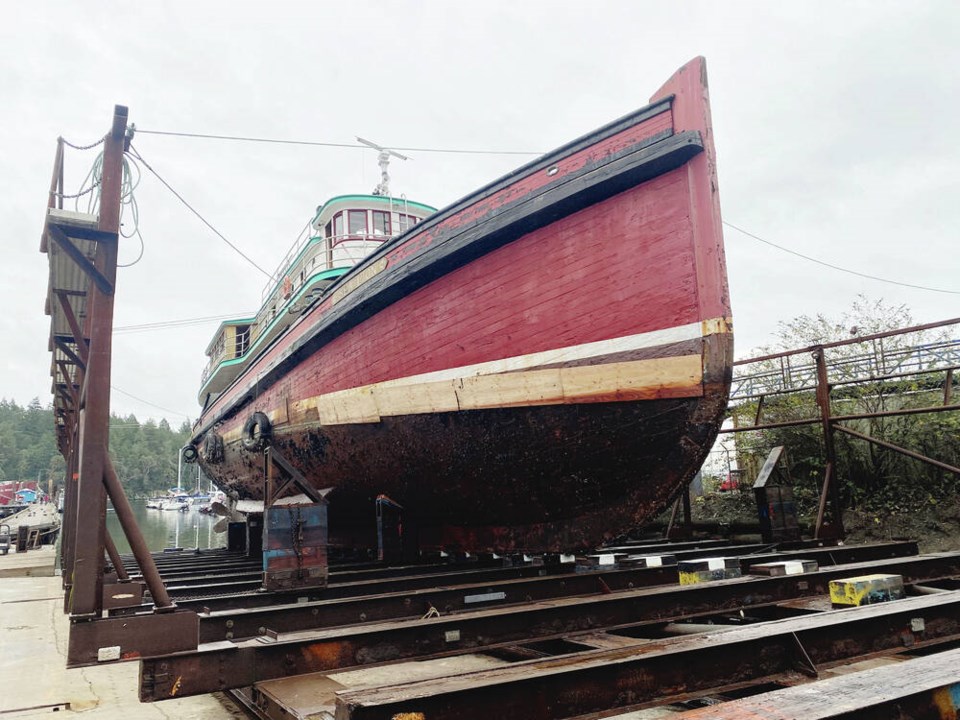The MV Sea Lion, the oldest wooden tug boat on the West Coast, played a significant role in the province’s forestry and maritime industries — and an infamous one in its social past.
Now, all that’s left of the 116-year-old tug is a partial skeleton — its planks have been stripped away and salvageable parts stockpiled for museums by crews at the Canadian Maritime Engineering yard in Nanaimo.
“It had lots of character, lots of interesting history … and it’s with a heavy heart that I’m doing this project,” Jim Drummond, project lead on the 114-foot Sea Lion’s demolition, said this week.
The Sea Lion was the first tug to pull massive Davis log rafts weaved together with chains and cables, some 500-feet long and carrying 2.5 million board feet of lumber. The tug answered the call for spruce used in aircraft production during the First World War and for lumber during the Second World War.
The Sea Lion was also at the centre of the conflict involving the migrant freighter Komagata Maru, when 340 Sikhs, 12 Hindus and 24 Muslims tested sa国际传媒’s immigration laws in 1914. That summer, the tug was loaded with 125 armed immigration officers and police in an attempt to force the freighter from Vancouver harbour, but angry passengers repelled the tug by throwing coal and bricks.
The Komagata Maru was eventually escorted out by the Sea Lion and a warship after a court ruled it was not allowed to land. The event remains a scar on Canadian history.
The Sea Lion worked as a tug until 1969 and lived many lives and engine changes since, through several owners — as a private yacht, liveaboard home, charter boat, eco-tour vessel and fishing lodge.
Drummond, who grew up in boatyards on the coast and lived and worked aboard tugboats, watching the Sea Lion at work several times, says he wanted to be part of the famous tug’s “final chapter.”
The Sea Lion had been sitting derelict in Maple Bay for the past five years and was removed in November because of environmental concerns, after the abandoned vessel began listing to one side.
There was initial interest in preserving the tug. But in the end, preservation proved too costly.
“It was either going to be someone with very deep pockets, or a government job,” said Drummond. “And that just didn’t happen.”
So Drummond’s $393,000 bid to dismantle the tug was accepted by the federal government.
The Sea Lion was built on a one-piece keel from a 120-foot fir log, milled three feet deep and two feet wide, and launched into the waters at Coal Harbour in Vancouver in 1905.
At 218 gross tons, the original Sea Lion was powered by a single McKie and Baxter triple expansion marine steam engine, and soon developed a reputation as one of the best pullers on the coast.
In his book Against Wind and Weather: The History of Towboating in British Columbia, Ken Drushka called the Sea Lion “the classic log-towing boat.”
It had power and seaworthiness, but it was also designed for crew. Drushka said it had a spacious salon, equipped with a piano, and “the whistle had a sliding scale upon which the crew played a somewhat haphazard repertoire of songs, learned and practiced during the long tows down the coast.”
The Sea Lion had a number of unusual features for a tug at that time, Drushka said, including steam-powered steering gear and towing winch, a steel towline, dual steering and engine controls on the aft deck, and eventually, the first ship-to-shore radio and searchlight in sa国际传媒
Drummond marvels at the original craftsmanship of the tug. “The joinery work is incredible,” he said. “I think of all the hours poured into building this boat and how they did everything without power tools. They used chisels, adzes, planes — everything was by hand.
“To do a restoration on this tug, you would need dozens of people working for two years. Where would you get the money for that? And where would you find the people? They just don’t exist anymore.”
Some wooden planks have been salvaged, and portholes, doors, railings, a few fixtures from the interior cabin and plaques from the engine room have been set aside. The Royal sa国际传媒 Museum has requested some pieces for its collection, and some planking is being sent to a national Sikh association in Toronto that requested a part of the tug, said Drummond.
He said many of the original features had been stripped away by various owners over the years, and more recently, “pirates” arriving by water around the Nanaimo yard have taken more.
One former crew member in his 80s who showed up at the Canadian Maritime Engineering yard in Nanaimo with papers showing he worked aboard the Sea Lion was given an undisclosed piece of the tug.
“It brought tears to his eyes,” said Drummond.



